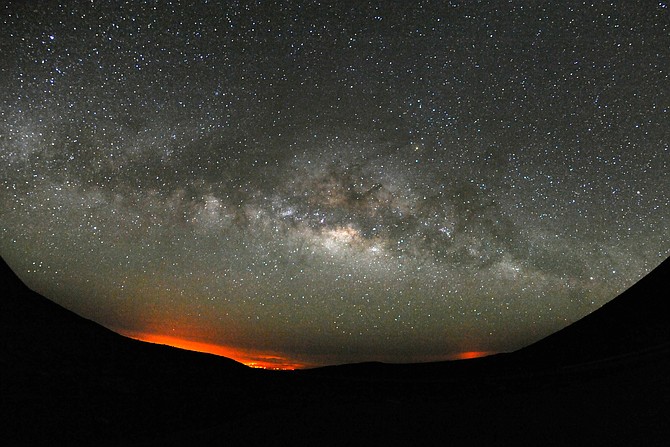
Faint and misty, soft as silk, Some say you are made of milk. Road to heaven, river of light, Glowing star clouds fill the night.
— Jimmy Westlake, 2010
When the bright moon is not in the sky, the dark summer night reveals one of its most spectacular treasures — the soft, misty glow of the Via Lactea, or the Milky Way.
Contrary to what the ancient Romans believed, the Milky Way is not made from the milk of queen goddess Juno, but is the combined light of billions of distant suns unresolved by the human eye. If you look through a pair of binoculars and sweep slowly across the Milky Way, you will rediscover what Galileo did in 1610 — a multitude of faint stars.
The situation is analogous to soaring high over a sandy beach and seeing the white sand stretch for miles in both directions, and yet, you cannot see the individual sand grains that make up the beach from that height. In the case of the Milky Way, the grains of sand are the myriad stars that populate our galaxy. Our Sun is but one grain of sand on this cosmic beach. Think about that as you dump a million sand grains out of your shoe on your next visit to the beach.
The Milky Way is our home galaxy, a swirling collection of hundreds of billions of stars more or less like our Sun. The word “galaxy” literally means “milk,” from the Greek word “galax.” Because it is flattened like a pancake and we peer outward from within that pancake, we see the Milky Way’s arms wrapped gently around us in a narrow band that runs almost north to south on summer evenings. Our view of the Milky Way is from a position about two-thirds of the way out from the center to the edge, out in the galactic suburbs.
One of the brightest portions of the Milky Way is seen just above the spout of the Teapot asterism of Sagittarius, hanging low in our southern sky around 11 p.m. this month. When we peer off into this direction, we are looking directly toward the center of the Milky Way galaxy, some 28,000 light years away. We cannot view the center directly because of the intervening stars, gas and dust, but there is mounting evidence that a supermassive black hole lurks there. Astronomers are struggling with the chicken/egg question of which came first — the Milky Way galaxy or the gargantuan dark monster at its core?
Experiencing the subtle beauty of the Milky Way has become a privilege many Americans might never have. A large majority of our nation’s population lives in or near a large city where human light pollution drowns out this natural wonder. To them, the Milky Way is something you see pictures of in a book or see a poor rendition of in a planetarium. Streetlights and spotlights aimed skyward scatter so much unnecessary light into the night sky that it overwhelms all but the brightest stars. Many cities are making efforts to curb this urban light pollution to preserve the beauty of the nighttime sky. The International Dark-Sky Association, or IDA, is the only non-profit organization fighting to preserve the night. For more information, check out their website at darksky.org.
For the time being at least, here in northwestern Colorado, all we have to do is step out into our backyard to see the galaxy of which we are a part, the magnificent Milky Way.
Professor Jimmy Westlake teaches astronomy and physics at Colorado Mountain College’s Alpine Campus. His “Celestial News” column appears weekly in the Steamboat Today newspaper and his “Cosmic Moment” radio spots can be heard on local radio station KFMU. Check out Westlake’s astrophotography website at www.jwestlake.com.
